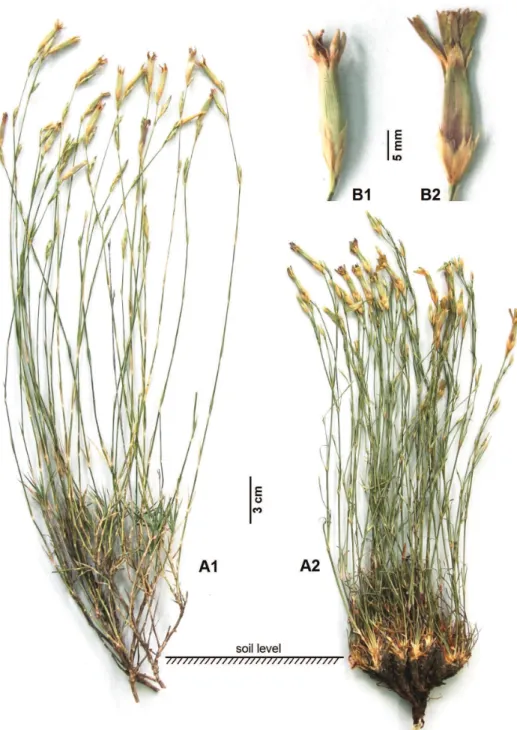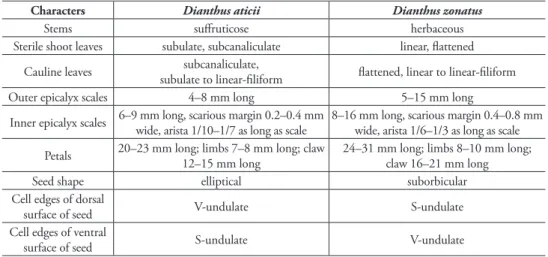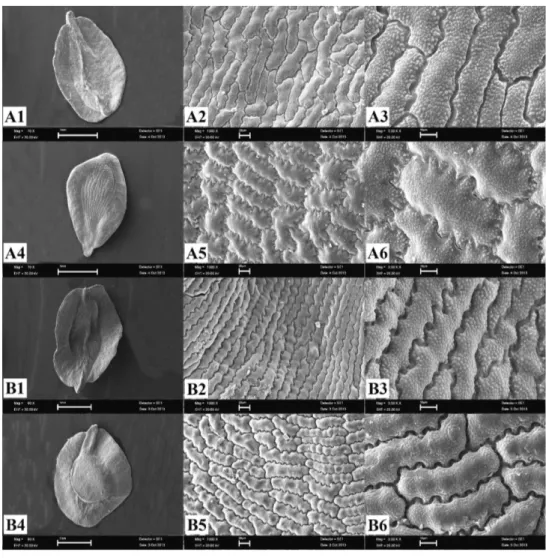Dianthus aticii
, a new species from Turkey
(Caryophyllaceae)
Ergin Hamzaoğlu1, Murat Koç2, Ahmet Aksoy3
1 Department of Elementary Education, Gazi Faculty of Education, Gazi University, 06500, Ankara, Turkey
2 Animal Production High School, Bozok University, 66900, Yozgat, Turkey 3 Department of Biology, Science Faculty, Akdeniz University, 07058, Antalya, Turkey
Corresponding author: Ergin Hamzaoğlu (erginhamzaoglu@yahoo.com)
Academic editor:C. Morden | Received 4 January 2015 | Accepted 24 March 2015 | Published 2 April 2015
Citation: Hamzaoğlu E, Koç M, Aksoy A (2015) Dianthus aticii, a new species from Turkey (Caryophyllaceae). PhytoKeys 48: 21–28. doi: 10.3897/phytokeys.48.4446
Abstract
During the taxonomic revision of the Turkish Dianthus species, specimens collected from Bilecik, Seben (Bolu), and Nallıhan (Ankara) were discovered that represent a new species. Its description, images, chorology, ecology, and threat category are provided. It was compared with a closely related species,
D. zonatus, and diferences are based on its general morphology and seed micromorphology.
Keywords
Dianthus, new species, section Dentati, taxonomy, Turkey
Introduction
he genus Dianthus L. (or carnation, pink, sweet william) is easily distinguished from the other genera in the family Caryophyllaceae by its epicalyx scales, tubular calyx, and peltate seeds. Furthermore, it is the second largest genus of the family in Turkey, with the highest number of species after Silene L. (Reeve 1967, Bojňanský and Fargašová 2007). his genus consists of approximately 300 species and is mainly distributed across the Mediterranean region of Europe and Asia (Bittrich 1993).
he most comprehensive taxonomic revision of Dianthus species of Turkey was carried out by Reeve (1967), who recognized 67 species from this region. Since Reeve’s revision, nine species have been added (Davis et al. 1988, Gemici and Leblebici 1995, http://phytokeys.pensoft.net
Copyright Ergin Hamzaog˘lu et al. This is an open access article distributed under the terms of the Creative Commons Attribution License (CC BY 4.0), which permits unrestricted use, distribution, and reproduction in any medium, provided the original author and source are credited.
Güner 2000, Menemen and Hamzaoğlu 2000, Aytaç and Duman 2004, Özhatay and Kültür 2006, Vural 2008, Yılmaz et al. 2011, İlçim et al. 2013), bringing the current total to 76 species.
In the course of performing a taxonomic revision of Dianthus species of Turkey, specimens from Bilecik, Seben (Bolu), and Nallıhan (Ankara) were identiied as D.
zonatus Fenzl based on their appearance and present-day key characteristics. However,
on further study, it was revealed that they belonged to a new species. his study was undertaken to recognize this new species and to characterize the diferences between these two species.
he specimens collected from Bilecik, Seben (Bolu), and Nallıhan (Ankara) were found to be distinct from those of D. zonatus on the basis of vegetative, loral, and seed characteristics (Table 1). Vegetative characters of the new species include a sufruticose habit as opposed to herbaceous in D. zonatus, and leaves that are subulate and sub-canaliculate rather than linear and lattened. Floral characters of the epicalyx and petals are smaller than those of D. zonatus, and seed shape and seed cell traits are distinctive between the two species. Based on these diferences, it was clear that these specimens represent a previously undescribed species.
Materials and methods
Dianthus specimens were thoroughly evaluated using the relevant literature (Fenzl
1842, Boissier 1849, Tchihatchef 1860, Reeve 1967, Bojňanský and Fargašová 2007) and the specimens present in GAZI herbarium. Furthermore, the specimens collected from the Bilecik population included the material needed for the seed micromorphology studies. Images were taken using a Canon EOS 60D digital camera, and the seed surface micromorphology was visualized using a LEO 440 scanning electron microscope. Normal visualization of the specimens was carried out using a Leica EZ4 HD microscope. he vegetative characters were measured using a ruler with 0.5 mm accuracy; loral characters were measured using an ocular micrometer. Seed morphology is described following the nomenclature of Bojňanský and Fargašová (2007). Specimens have been deposited in the herbaria of Gazi (GAZI) and Ankara Universities (ANK).
Taxonomic treatment
Dianthus aticii Hamzaoğlu, sp. nov. urn:lsid:ipni.org:names:77146130-1 Figs 1, 2
0.2–0.4 mm wide, arista 1/10–1/7 as long as scale (not with scarious margin 0.3–0.8 mm wide, arista 1/7–1/3 as long as scale).
Type. TURKEY. Bilecik: Bilecik highway exit towards Eskişehir, 40°06'27"N, 29°59'47'E, 330 m, stony slopes and steppes, 16 June 2013 (l, fr), E. Hamzaoğlu et
al. 6743 (holotype: GAZI; isotypes: GAZI, ANK); Bolu: Seben, between Bozyer and
Korucuk villages, 1025 m, forest clearings, lowing slopes, 19 July 2013, M. Koç & E.
Hamzaoğlu 6868 (paratypes: GAZI, ANK); Ankara: Nallıhan, Gökçeöz village, road
of forest watchtower, 820 m, forest clearings, stony slopes, 19 July 2013, M. Koç & E.
Hamzaoğlu 6869 (paratypes: GAZI, ANK).
Specimens examined. Dianthus aticii Hamzaoğlu sp. nov. – TURKEY.
Bil-ecik: Bilecik highway exit towards Eskişehir, 40°06'27"N, 29°59'47'E, 330 m, stony slopes and steppes, 16 June 2013, E. Hamzaoğlu et al. 6743 (holotype: GAZI; isotypes: GAZI, ANK); Bolu: Seben, between Bozyer and Korucuk villages, 1025 m, forest clear-ings, lowing slopes, 19 July 2013, M. Koç & E. Hamzaoğlu 6868 (paratypes: GAZI, ANK); Ankara: Nallıhan, Gökçeöz village, road of forest watchtower, 820 m, forest clearings, stony slopes, 19 July 2013, M. Koç & E. Hamzaoğlu 6869 (paratypes: GAZI, ANK); Dianthuszonatus Fenzl – TURKEY. Manisa: Spil Dağı National Park, road of Atalanı resting area, 1320 m, calcerous rocks, 2 July 2011, M. Koç & E. Hamzaoğlu 6106 (GAZI); Kütahya: İscehisar, around Seydiler, 1150 m, rocks, 5 August 2012,
E. Hamzaoğlu et al. 6584 (GAZI); Eskişehir: Around Sivrihisar, 1115 m, rocks, 24
June 2012, E. Hamzaoğlu et al. 6339 (GAZI); Konya: Between Kulu and Cihanbeyli, Kulu exit, 1130 m, steppe, 13 July 2011, E. Hamzaoğlu et al. 6122 (GAZI); Ankara:
Polatlı, above Babayokuş village, 900 m, stony places, 2 July 2010, M. Koç et al. 1205
(GAZI); Aydın: Between Söke and Didim, after 4 km from Güllübahçe exit, 820 m, 25 June 2006, E. Hamzaoğlu et al. 4071 (GAZI); Muğla: Köyceğiz, above Yayla vil-lage, from Gökçeova Lake to Sandras Mountain summit, 1950 m, serpentine rocks, 15 July 2011, E. Hamzaoğlu et al. 6198 (GAZI); Antalya: Elmalı, N of Vahhabi Ümmi Türbesi, 1480 m, rocks, 12 June 2007, M. Koç & Ü. Budak 2152 (GAZI); Karaman:
Between Ermenek and Karaman, 16 km, 1670 m, Pine forest openings, stony places, 18 July 2005, Ü. Budak et al. 1743 (GAZI); Niğde: Çamardı, above Demirkazık vil-lage, 1475 m, rocks, 11.7.2012, E. Hamzaoğlu et al. 6449 (GAZI).
scari-Figure 1. Photographs of plant habit and lowers of D. aticii and D. zonatus. Dianthus aticii – A1 Habit
ous (c. 0.2 mm) margins, arista 1/2–2/3 as long as scale; inner oblong-oblanceolate, veinless below, indistinctly 7–9-veined above, 2/5–1/2 as long as calyx, 6–9 × 2.5–3.5 mm, with scarious (0.2–0.4 mm) margins, arista 1/10–1/7 as long as scale. Calyx cy-lindric-lanceolate, 16–22 × 3–4.5 mm, distinctly 36–40-veined above, glabrous or pu-berulent, pale green or sometimes purplish; teeth triangular-lanceolate, 4–5.5 × 1.2–2 mm, 7-veined, with ciliate and scarious margins, apex acute to acuminate, sometimes short mucronate. Petals 20–23 mm long; limb broadly cuneate, 7–8 × 6–7 mm, c. 1/3 as long as petal, completely exserted from calyx, usually spotted, barbulate, pink, yellowish-green beneath, 7–11-toothed to apex, teeth triangular, up to 1/6 as long as limb; claw 12–15 × 1.5 mm, collar almost as wide as claw. Capsule equal in length to calyx. Seeds elliptical, 2–3 × 1.4–2 mm, blackish.
Distinction from other taxa. Dianthus aticii shows close similarities to D. zonatus
Fenzl because of toothed and barbulate petals, solitary or double lowers, and epicalyx scales that reach up to half of its calyx length (Fenzl 1842, Boissier 1849, Tchihatchef 1860, Reeve 1967). Despite these similarities, there are very distinctive diferences between D. aticii and D. zonatus such as stem morphology, leaf shape, and size of epi-calyx scales and petals (Table 1, Figure 2).
Key to the two closely related Dianthus species
1 Stems sufruticose; sterile shoot leaves subulate and subcanaliculate; inner epicalyx scales with scarious margin 0.2–0.4 mm wide; petals 20–23 mm long ...D. aticii sp. nov. – Stems herbaceous; sterile shoot leaves linear and lattened or absent; inner
epicalyx scales with scarious margin 0.3–0.8 mm wide; petals 24–31 mm long ...D. zonatus
Table 1. Diagnostic characters between Dianthus aticii and D. zonatus.
Characters Dianthus aticii Dianthus zonatus
Stems sufruticose herbaceous
Sterile shoot leaves subulate, subcanaliculate linear, lattened
Cauline leaves subulate to linear-iliformsubcanaliculate, lattened, linear to linear-iliform
Outer epicalyx scales 4–8 mm long 5–15 mm long
Inner epicalyx scales 6–9 mm long, scarious margin 0.2–0.4 mm wide, arista 1/10–1/7 as long as scale
8–16 mm long, scarious margin 0.4–0.8 mm wide, arista 1/6–1/3 as long as scale
Petals 20–23 mm long; limbs 7–8 mm long; claw 12–15 mm long
24–31 mm long; limbs 8–10 mm long; claw 16–21 mm long Seed shape elliptical suborbicular Cell edges of dorsal
surface of seed V-undulate S-undulate Cell edges of ventral
Figure 2. SEM photographs of the seed coat. ADianthus aticiiBD. zonatus 1–3 dorsal surface 4–6 ventral surface (scale bars: 1 and 4: 1 mm, 2 and 5: 20 μm, 3 and 6: 10 μm).
Seed morphology. Seeds of Dianthus aticii are elliptical, 2–3 × 1.4–2 mm, black, granular; dorsal surface convex, with regular rectangular cells, tuberculate, with 4–7 teeth on each margin, teeth V-undulate, apparent; ventral surface lat, with irregular rectangular cells, tuberculate, with 4–7 teeth on each margin, teeth S-undulate, not ap-parent; apex beaked. he seeds of D. aticii are diferent from the seeds of D. zonatus in terms of shape and cell edges of both the dorsal and ventral surfaces (Table 1, Figure 2).
Phenology. he new species was observed lowering in June and July, in stony slopes and steppes, between 330 and 1025 m.
compared with the oceanic climate zone, were occupied by some semi-xeric species. hese areas where the forest and steppe formations co-exist are the ideal habitats for D.
aticii. he species grows on stony slopes within forest openings together with Quercus
pubescens Willd., Juniperus oxycedrus L., Crataegus monogyna Jacq. subsp. monogyna,
Cistus creticus L., Jasminum fruticans L., Helianthemum nummularium (L.) Miller,
Fu-mana thymifolia (L.) Verlot, Alyssum sibiricum Willd., Silene italica (L.) Pers.,
Pilo-sellapiloselloides (Vill.) Sojak, Onosmatauricum Pallas ex Willd., Veronicamultiida L.,
Teucriumpolium L., Acantholimonacerosum (Willd.) Boiss., Hypericumperforatum L.,
Genistatinctoria L., Viciacracca L. subsp. stenophylla Vel., Astragalusvulnerariae DC.,
Astragalusmicrocephalus Willd., Rosa canina L., and Centaurea urvillei DC.
Conservation status. According to the current data Dianthus aticii grows in the Bilecik, Seben (Bolu), and Nallıhan (Ankara) districts, which have an area of ap-proximately 7000 km2. his has a discontinuous distribution due to dense forests, settlement, and farming areas. he open areas, which this species prefers, have the potential of possible settlements and agricultural activities. herefore, the habitat of this species is under danger of being decreased and disturbed/destroyed in the fu-ture. herefore, it is proposed that the species should be classiied as Vulnerable [VU (B1b-iii) according to the International Union for Conservation of Nature (IUCN) categories (IUCN 2014)].
Etymology. he species is named in honour of the eminent Turkish hydrobiologist Prof Dr Tahir Atıcı (Gazi Faculty of Education, Gazi University, Ankara).
Acknowledgements
We wish to thank TÜBİTAK (Project number: KBAG-111T873) for inancial support and the Curator of the Herbaria Gazi University (GAZI), who allowed us to study their Dianthus specimens.
References
Aytaç Z, Duman H (2004) Six new taxa (Caryophyllaceae) from Turkey. Annales Botanici Fennici 41: 213–223.
Bittrich V (1993) Caryophyllaceae. In: Kubitzki K, Rohwer J, Bittrich V (Eds) he Families and Genera of Vascular Plants, Magnoliid, Hamamelid, and Caryophyllid Families, Vol. 2. Springer, Berlin, 206–236. doi: 10.1007/978-3-662-02899-5_21
Boissier E (1849) Diagnoses Plantarum Orientalium novarum, Ser. 1(8). Typis Marci Ducloux et Cons, Paris, 67–68.
Bojňanský V, Fargašová A (2007) Atlas of seeds and fruits of Central and East-European Flora: he Carpathian Mountains Region. Springer, Dordrecht, 47–91.
Davis PH, Mill RR, Tan K (1988) Dianthus L. In: Davis PH, Mill RR, Tan K (Eds) Flora of Turkey and the East Aegean Islands (Suppl. 1), Vol. 10. Edinburgh University Press, Edinburgh, 71–72.
Fenzl E (1842) Pugillus Plantarum Novarum Syriæ et Tauri Occidentalis Primus. apud F. Beck, Vienne, 11.
Gemici Y, Leblebici E (1995) Seven new species for the Flora of Turkey. Candollea 50: 41–50. Güner A (2000) Dianthus L. In: Güner A, Özhatay N, Ekim T, Başer KHC (Eds) Flora of
Turkey and the East Aegean Islands (Suppl. 2), Vol. 11. Edinburgh University Press, Ed-inburgh, 48–49.
İlçim A, Behçet L, Mükemre M (2013) Dianthus vanensis (Caryophyllaceae), a new species from Turkey. Turkish Journal of Botany 37: 219–224.
IUCN Guidelines for Using the IUCN Red List Categories and Criteria. Version 11, February 2014. http://jr.iucnredlist.org/documents/RedListGuidelines.pdf [accessed 25 December 2014]
Menemen Y, Hamzaoğlu E (2000) A new species of Dianthus (Caryophyllaceae) from Salt Lake, Central Anatolia, Turkey. Annales Botanici Fennici 37: 285–287.
Özhatay N, Kültür Ş (2006) Check-list of additional taxa to the supplement Flora of Turkey III. Turkish Journal of Botany 30: 281–316.
Reeve H (1967) Dianthus L. In: Davis PH (Ed.) Flora of Turkey and the East Aegean Islands, Vol. 2. Edinburgh University Press, Edinburgh, 99–131.
Tchihatchef P (1860) Asie Mineure: description physique, statistique et arch́ologique de cette contŕe. Gide [et] Baudry, Paris, 222.
Vural C (2008) A new species of Dianthus (Caryophyllaceae) from mount Erciyes, Central Ana-tolia, Turkey. Botanical Journal of the Linnean Society 158: 55–61. doi: 10.1111/j.1095-8339.2008.00843.x


